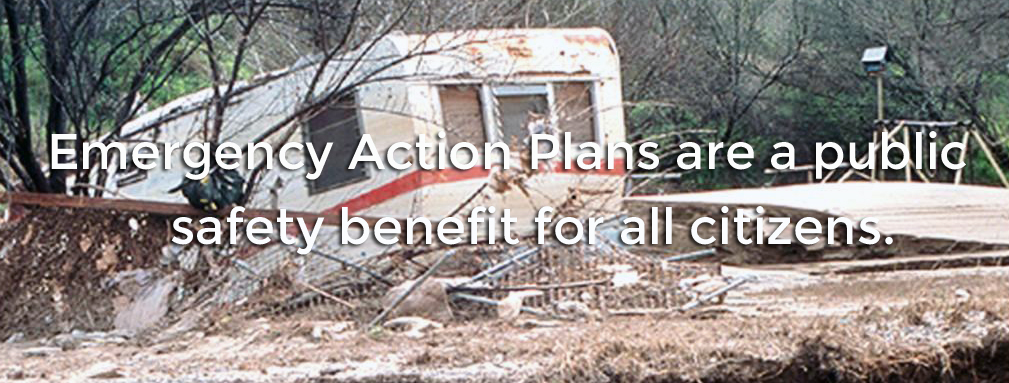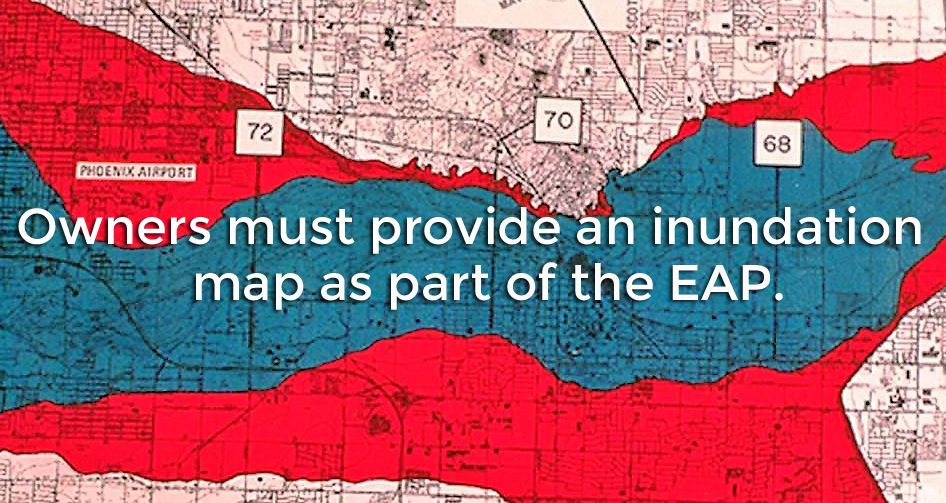
Emergency Action Plans (EAPs) help dam owners as well as people downstream. An EAP takes time, focus, and dedication.
The time is now.
The focus is on saving lives.
The dedication is to public safety.
An Emergency Action Plan (EAP) is a written document that identifies incidents that can lead to potential emergency conditions at a dam, identifies the areas that can be affected by the less of reservoir and specifies pre-planned actions to be followed to minimize property damage, potential loss of infrastructure and water resource, and potential loss of life because of failure or mis-operation of a dam.

The dam owner is responsible for development, maintenance, and exercise of the EAP; however, there are guidelines, tools and assistance available to help owners. City, county and state emergency management directors and state dam safety officials stand ready to partner with dam owners to create and exercise EAPs. An owner can tap into this technical and emergency management expertise and can get additional support by using state and national educational materials, EAP forms and examples, and step-by-step guidelines.
The dam owner initiates the EAP process and both emergency responders and owners will be users of the EAP. The completed document should have had input from emergency managers, state dam safety officials, leaders of downstream communities and, directly or indirectly, everyone who may be responsible for the proper implementation of the EAP. It is important that the dam owner stays involved throughout the entire process.
All potentially hazardous dams benefit from some type of an Emergency Action Plan. Obviously dams with a potential for loss of life or damage to infrastructure or high value property in the event of failure (typically identified by regulators as High-Hazard Potential) would be a higher priority and would require a more sophisticated and detailed plan. The regulatory agency responsible for dam safety will probably have criteria for the type and detail of EAP required and the required priority if major repairs are also needed (in many states, dam owners are legally obligated to provide EAPs for certain dam hazards). Regardless of the requirement for a recorded or documented EAP by the Dam Safety Regulatory Program, every dam owner is strongly encouraged to develop some type of EAP that can be used to implement emergency action response in the event of a dam incident.

Regardless of state or federal regulatory requirements, dam owners are responsible and liable for dam operations and any related incidents. EAPs can actually limit a dam owner’s liability in the field and in the courtroom because it shows the proper diligence and reasonable actions expected by the law and the dam industry.
Time and effort must be devoted to creating an EAP, filing it appropriately with state and local officials, updating plan details, testing the plan’s assumptions and functionality, and following its procedures in an emergency. Completion of an EAP demonstrates that a dam owner is actively attempting to prevent and mitigate harm to persons and property.
Be sure to note what you are responsible for, and plan accordingly.
Contact your state dam safety regulatory office and your consulting engineer.
You can locate your state’s office by visiting the ASDSO website (www.damsafety.org/states). ASDSO can point you toward its industry membership to assist in locating a consulting engineer.
Contact the state and local emergency management coordinator.
The primary means of notification to the public is the National Weather Service (NWS). The NWS has the Congressional mandate for issuing flood warnings, which include dam failure. The NWS has a well-established warning infrastructure that includes access to the Emergency Alert System, Weather Radio network, and Internet-based mechanisms.
The ASDSO website houses national guidelines on dams. Go to:
DamSafety.Org/ManualsandGuidelines
Watch for training in you area sponsored by ASDSO or your State Dam Safety Office. Access your state's Dam Safety Program by clicking your state at:
DamSafety.org/States
FEMA Fact Sheet on Emergency Action Planning (FEMA National Dam Safety Program)
Fact Sheet on Emergency Operations Planning (FEMA National Dam Safety Program)
Fact Sheet on Risk Communication for Dams (FEMA National Dam Safety Program)
To encourage and facilitate development of EAPs at all high and significant hazard potential dams, ASDSO and the EAP Workgroup of the NDSRB have developed simple and low-cost tools for creating and implementing an EAP at their dam(s). One of the resources was a EAP fillable form template. This template can be easily edited for specific dams and the needs of local emergency management agencies.
Fact Sheet
EAP Template
Instructions
In 2009, a task group under the National Dam Safety Program developed the recommendation in the methodology and fact sheet below. The recommendations are provided to assist states and dam owners in developing reduced cost Simplified Inundation Mapping (SIMS) for EAPs. They are not a substitute for engineering judgment nor do they alleviate the need to comply with state or federal regulatory requirements.
SIMS Fact Sheet
SIMS Methodology
The Department of Homeland Security and FEMA make several publications and videos available through their websites. Visit their websites below and search "dam safety" for more information.
FEMA.gov
DHS.gov
The Dam Owner Academy is a series of videos to educate and inform owners on all aspects of operating and maintaining a dam safely. The videos concisely present the critical basics of owner responsibilities and are available as a free resource for owners and those conducting owner outreach programs.
The "Emergency Planning" video will cover the key components of an Emergency Action Plan and how you can prepare one for your dam.